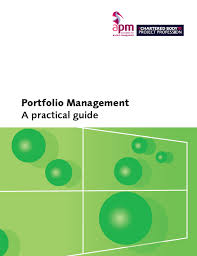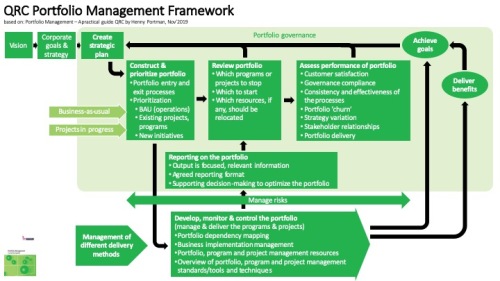 Portfolio Management – A practical guide is a publication from the APM Portfolio Management specific Interest Group written by Steve Leary, Richard Moor, Marina Morillas Lara, Stephen Parrett, Lynne Ratcliffe and Adam Skinner.
Portfolio Management – A practical guide is a publication from the APM Portfolio Management specific Interest Group written by Steve Leary, Richard Moor, Marina Morillas Lara, Stephen Parrett, Lynne Ratcliffe and Adam Skinner.
Portfolio management contributes to organizations in many crucial ways:
- Provides a focal point for strategic goals
- Ensures the prioritization of the goals, with prioritization rules for projects and programs that are clear and unambiguous
- Helps ensure the whole board and executives are fully behind the approach, are sponsoring the portfolio and are actively championing portfolio management and empowering a capable team
- Provides the capability to assess all key change factors
- Considers in-flight projects and programs and business as usual (BAU) in the same way and ensure full alignment to the strategic goals
- Ensures ‘tactical’ projects contribute to the strategic goals – if they don’t, don’t do them
- Embeds portfolio governance into the organization’s controls and makes it robust
- Critically assesses what information is really needed to make portfolio decisions
- Provides the means to be consistent and fair across the portfolio, irrespective of the program or project sponsor’s influence.

To download: QRC (PfM A practical guide, 191129) v1.0
The guide is divided into four main sections. The first section – Introduction to portfolio management explains the basics of portfolio management. How it can contribute to organizations, when you can benefit from portfolio management and where it fits in your organization.
The second part – Adopting portfolio management deals with the link to the existing organizational processes like strategic planning, stakeholder engagement, risk management and benefits. Different delivery methodologies (traditional, agile, hybrid) and their impact are discussed.
Part three – Portfolio management core processes looks at the underlying processes of portfolio management. See the QRC for the flow of processes: create strategic plan, construct & prioritize portfolio, review portfolio, assess performance of portfolio, reporting on the portfolio and develop, monitor & control the portfolio.
The last section – Implementing portfolio management illustrates how an organization will need to clearly and unambiguously identify what will deliver value for them, and then adapt the practice of portfolio management to their needs. Governance roles and the relationship to organizational governance are explained.
The book ends with an overview of challenges for portfolio management:
- Lack of clarity of the organization’s vision, goals and strategy
- Lack of board-level consensus
- Priorities not clearly defined or understand
- Resources and their allocation not optimized
- Lack of portfolio management skills
- Inadequate or overly bureaucratic portfolio controls
- The cultural challenge
- Limited perception of portfolio management
- Portfolio management is seen as just the latest management idea.
Conclusion: If you are new to portfolio management or a senior manager this book will help to understand the basics of portfolio management. If you are an expert in portfolio management, you will recognize most of it and you can use this book to promote the added value of portfolio management.
To order: Portfolio Management – A practical guide
















Pingback: New PM Articles for the Week of November 25 – December 1 | The Practicing IT Project Manager
I may be biased as part of the group that drafted, reviewed and published the Guide – but it really does provide that level of insight and context to make it useful in practice!
Pingback: Overview of my year 2019 book reviews | Henny Portman's Blog
Pingback: Quick Reference Cards in 2019 | Henny Portman's Blog